In this kit:
- Book Summary Pages (Online & Printable Kit)
In Printable Kit Only: Detailed summaries for each story paired with discussion questions specific for each story - Main Characters Page (Online & Printable Kit)
In Printable Kit Only: Detailed character listings for each story - Discussion Questions Page (Online & Printable Kit)
In Printable Kit Only: Detailed discussion questions specific for each story - Book Quotes Page (Online & Printable Kit)
- Icebreaker Game: (Printable kit only)
- About the Author Page (Online & Printable Kit)
- Historical Facts Surrounding Eve in Hollywood (Online & Printable Kit)
- List of Podcasts and Videos about this Book (Online only)
- Meeting Decoration Ideas (Online & Printable Kit)
- Meeting Decorations Printable Images (Printable kit only)
- Meeting Menu Ideas (Online & Printable Kit)
- Meeting Food Recipes (Printable kit only)
- The Golden Age of Hollywood printable images (Printable kit only)
- Bookmarks for Table for Two (Printable kit only)
- Bookmarks for Readers With Wrinkles (Printable kit only)

Table for Two is a 2024 collection of short fiction by bestselling author Amor Towles, featuring six short stories and one novella that explore themes of chance encounters, relationships, and life-changing conversations. The book is divided into two distinct parts: six stories set primarily in New York City around the turn of the millennium and a novella titled Eve in Hollywood set in 1938 Hollywood.
The New York Stories
The six short stories are all connected to New York City and explore the complexities of modern life, relationships, and brief encounters that can alter the course of one's existence.
"The Line" follows Pushkin, a Russian peasant whose wife, inspired by Bolshevik ideals, moves them from their village to Moscow and eventually to New York City, where Pushkin finds comfort in the familiar routine of waiting in a soup kitchen queue.
"The Ballad of Timothy Touchett" tells the story of an aspiring novelist who becomes an assistant to a rare bookseller, only to become unwittingly involved in a literary forgery scheme that ultimately lands him in legal trouble.
"Hasta Luego" depicts an unexpected connection between two strangers who are stranded at an airport due to inclement weather, exploring how brief encounters can lead to meaningful exchanges.
"I Will Survive" examines the consequences of a lawyer's secret passion for roller skating and explores themes around hidden aspects of people's lives.
"The Bootlegger" centers on a man's moral dilemma when he confronts an elderly patron who is illicitly recording performances at Carnegie Hall—a partly autobiographical story inspired by Towles's own experience at the venue.
"The DiDomenico Fragment" follows a retired art specialist named Percival Skinner as he attempts to locate pieces of a famous painting that has been divided among his family members.
Expanded summaries for each of the short stories are available in the printed Book Club Kit.
Eve in Hollywood
Eve in Hollywood, the novella that anchors Amor Towles’s short story collection Table for Two, follows the adventures of Evelyn (Eve) Ross, a character first introduced in Towles’s debut novel, Rules of Civility. In September 1938, Eve leaves New York City with the intention of returning to her family in Indiana. However, as her train pulls into Chicago, she impulsively decides to continue her journey to Los Angeles instead, setting the stage for a new life in Hollywood’s Golden Age.
Upon arriving in Los Angeles, Eve—a striking, intelligent woman whose blond beauty is marked by a facial scar from a car accident—quickly adapts to her new surroundings. She befriends Charlie Granger, a widowed former homicide detective whom she met on the train. Their friendship deepens as they navigate the vibrant, sometimes seedy world of 1930s Los Angeles, filled with movie sets, bungalows, and dive bars.
Eve’s life takes a dramatic turn when she befriends Olivia de Havilland, the famous starlet who has just enjoyed success with The Adventures of Robin Hood. Their friendship is genuine, and Eve soon becomes a confidante and protector to Olivia, who is struggling both with the paternalistic studio system and with a blackmail plot involving surreptitiously taken nude photographs. In classic noir fashion, the central antagonist is an untrustworthy, portly man who is at the heart of the blackmail scheme.
With the help of Charlie and a has-been actor named Prentice, Eve orchestrates a plan to outwit the blackmailers and protect Olivia’s reputation and autonomy. The story is told from multiple perspectives—seven in total—giving readers insight into the motivations and experiences of each key character. Through wit, resourcefulness, and a touch of mischief, Eve not only resolves the crisis but also forges new friendships and a sense of belonging in Hollywood.
Eve in Hollywood is a stylish, noir-inflected tale that explores themes of reinvention, friendship, and the power of unexpected encounters. Towles’s signature wit and sophistication shine through as Eve—cool, fearless, and empathetic—crafts a new future for herself and those around her, all within the glittering, treacherous world of 1930s Los Angeles.

The Short Stories' Main Characters
The six New York-based stories each center on distinct protagonists facing pivotal moments in their lives. Pushkin serves as the main character in "The Line," a Russian peasant who develops a unique talent for waiting in lines and making friends in the process. His story spans from a small Russian town to Moscow in 1918 and ultimately to New York City, demonstrating how someone intent on being happy can find contentment anywhere.
Timothy Touchett is the protagonist of "The Ballad of Timothy Touchett," an aspiring writer who feels he needs to suffer to create meaningful work. Having lived what he considers a fortunate life without the typical struggles that fuel great literature, Timothy finds himself seeking the hardship he believes necessary for his craft.
The other short stories feature various characters, including a man who befriends a fellow traveler during a weather delay, a concertgoer frustrated by someone secretly recording performances, and individuals navigating the complexities of modern relationships and brief encounters.
The printable Book Club Kit includes more about the characters in the short stories.
The Novella's Protagonist: Evelyn Ross
The collection's most significant character is Evelyn Ross, who serves as the main protagonist of the novella Eve in Hollywood. Originally introduced in Towles's novel Rules of Civility, Evelyn is described as an indomitable character who left New York City in September 1938 with plans to return home to Indiana. However, when her train reaches Chicago, where her parents are waiting, she instead extends her ticket to Los Angeles.
Evelyn is portrayed as a beautiful woman marked by a facial scar from a car accident and a limp, who possesses intelligence, fearlessness, and excellent judgment of character. In Hollywood, she befriends a diverse group, including Charlie Granger, a retired L.A. homicide detective, and a once-famous movie star who gave up stardom for comfort. The novella follows Evelyn as she navigates the movie sets, bungalows, and dive bars of 1930s Los Angeles, told from seven different points of view.
The title Table for Two reflects Towles's observation that in almost every story, critical moments occur when two characters sit across from each other at a small table, often in a kitchen, confronting significant elements of their lives. This recurring motif unites the diverse cast of characters, each facing transformative conversations that could change their futures.

Here’s a set of general discussion questions for Table for Two by Amor Towles. The Printable Kit includes discussion questions specific to each story and the novella. Since Table for Two is a collection of short stories (with one novella, Eve in Hollywood), these questions are designed to work for the collection as a whole.
General Collection Questions
- What themes do you see recurring throughout the stories in Table for Two? How do these themes connect or differ between stories?
- How does the setting (often glamorous or historical) influence the characters’ decisions and the outcomes of the stories?
- Which story resonated with you the most, and why?
- How does Amor Towles use language and style to create atmosphere and emotion in his stories?
- Many stories in this collection feature chance encounters or unlikely connections. How do these moments drive the plot or character development?
Character and Relationships
- How do the main characters in these stories deal with adversity or unexpected situations? What does this reveal about their personalities?
- Discuss the importance of relationships—romantic, platonic, or professional—in the stories. How do these relationships shape the characters’ lives?
- Are there any characters you found particularly sympathetic or frustrating? Why?
- How do characters change or stay the same throughout their stories?
- Do you think the characters’ choices are believable? Why or why not?
Specific Story Questions
(Pick a story to discuss, or use these as prompts for any story in the collection.)
- What is the central conflict of the story, and how is it resolved (or not resolved)?
- How does the time period or location of the story affect its mood and outcome?
- What role does fate or coincidence play in the story?
- Are there any symbols or motifs that appear in the story? How do they contribute to the overall meaning?
- Would you want to see a continuation or adaptation of any of these stories? Which one and why?
Reflection and Connection
- What did you learn about human nature or society from reading Table for Two?
- How does this collection compare to Towles’ novels (such as A Gentleman in Moscow or Rules of Civility)?
- If you could meet one character from any story, who would it be, and what would you ask them?
- Which story surprised you the most, and why?
- Would you recommend this collection to others? What kind of reader would enjoy it?
Feel free to customize these questions for your book club or discussion group!

Amor Towles is an acclaimed American novelist best known for his bestselling novels Rules of Civility (2011), A Gentleman in Moscow (2016), and The Lincoln Highway (2021). Before becoming a full-time writer, Towles worked in finance for over two decades. He turned to writing fiction in his forties, quickly gaining recognition for his elegant prose, well-drawn characters, and keen observations of human nature.
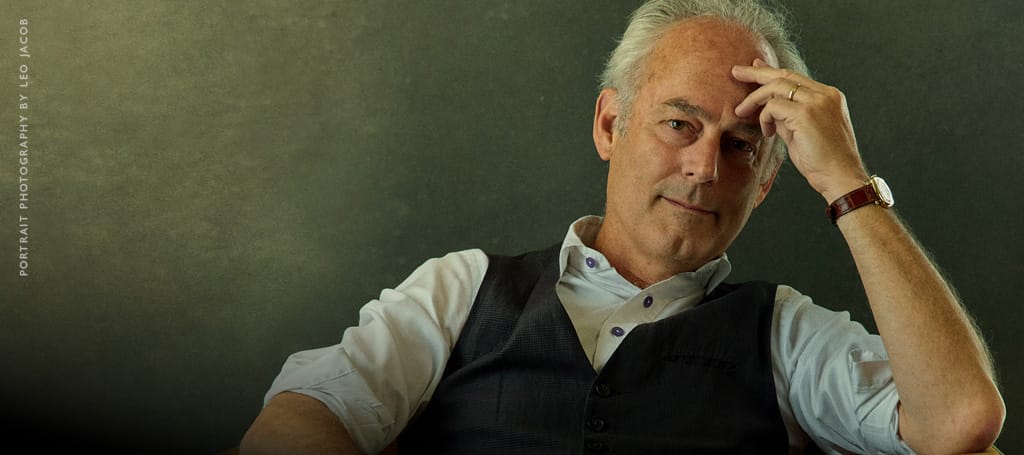
Why He Wrote Table for Two
The Table for Two short story and novella collection was compiled from Towles' writing over the past ten years. Towles has explained that he often turns to short fiction between novels, both as a creative variation and because he enjoys the form. He began writing short stories in high school and college, using the format to experiment with different approaches to characterization, setting, and tone.
The title Table for Two emerged late in the writing process. As Towles was preparing to submit the manuscript, he realized a recurring motif: in almost every story, there is a pivotal moment where two characters sit across from each other at a table—often in a kitchen or restaurant—hashing out significant elements of their lives. This led him to reflect that “our lives can often change materially due to a single conversation at a table for two.”
“I think we do end up eventually…literally or figuratively at the table with our spouse, with our child, with our sibling, with our colleague, with a potential lover…where life is being hashed out in real time. And where those conversations can have a great impact on the way the relationships evolve going forward.”
Towles has described this as a subconscious conviction, noting that the power of a conversation, a chance encounter, or a sudden decision to force a personal or historical reckoning animates the characters in the collection.
Some stories in Table for Two are drawn from Towles’s own experiences. For instance, the story “The Bootlegger” was inspired by his real-life irritation at seeing someone secretly record a performance at Carnegie Hall, which he witnessed himself.
Towles’s writing process for this collection involved working at his desk in the mornings and revising his work in restaurant bars in the afternoons. To capture the atmosphere for the novella set in Los Angeles, he even spent a week at The Beverly Hills Hotel, immersing himself in the city’s ambiance.

Reflecting on Human Nature and Self-Education
“The personality of a man always poses the biggest obstacle to his own education, thought Charlie. He’s either too proud, too stubborn, or too timid to submit to the process of discovery. Many of life’s lessons come through trial or tribulation, and the cost of those lessons shouldn’t be taken lightly. But at least half of what a man hasn’t learned in his lifetime he could have learned with ease. This is one of the insights that comes with age—when one understands the nature of discovery but no longer has the time or energy to submit to its splendors. Thus, we are doomed to end our days in an ignorance largely of our own making.”
On Group Dynamics and Reluctant Consensus
“It is a funny aspect of life, thought Charlie, how a group of grown people can convince themselves to do something that none of them really want to do. They start by talking an idea into existence. Once the idea begins to take shape and dimension, they'll talk away their hesitations, replacing them with all the supposed benefits, one by one. They'll talk away their instincts and their second thoughts and their common sense too, until they are moving in lockstep together toward some shared intention that doesn't appeal to any one of them.”
Family Traditions and Their Perpetuation
“The limitations of choosing a twenty-pound turkey as the centerpiece of the Thanksgiving meal have only been compounded by the inexplicable tradition of having every member of the family contribute a dish. Relatives who should never be allowed to set foot in a kitchen are suddenly walking through your door with some sort of vegetable casserole in which the ‘secret ingredient’ is mayonnaise. And when cousin Betsy arrives with such a mishap in hand, one can take no comfort from thoughts of the future, for once a single person politely compliments the dish, its presence at Thanksgiving will be deemed sacrosanct. Then not even the death of cousin Betsy can save you from it, because as soon as she’s in the grave, her daughter will proudly pick up the baton.”
On Social Status and Pompousness
“No one is born pompous. To attain that state requires a certain amount of planning and effort. Presumably you could achieve it by a variety of means, but one sure way is to attend an old prep school that’s a little past its prime; while there, exhibit some facility in a field sport that you will never have cause to play again; room with a fellow whose name is over the library door; and along the way, gain familiarity with a pastime that requires travel and specialized apparel—such as duck hunting or downhill skiing. Follow these simple steps and you are sure to gain the necessary self-assurance to expound authoritatively on wine, politics, and the lives of the less fortunate—and to generally go on and on about anything else.”
The Journey of Self-Discovery
“The road along which a young man discovers what he is capable of is no midwestern interstate. It has no uninterrupted views to the horizon, no painted white lines, no brightly lit signs indicating the distance to one’s destination. Rather, it is a narrow and winding byway crowded with undergrowth and overhung with branches.”
On Music and the Mind
“Say what you will about classical music, one thing it has going for it is that it lets your mind wander. Rock bands, blues bands—and yes, salsa bands too—they’re all intent on securing your undivided attention. That’s what the drums and amplifiers are there for. But classical musicians seem more willing to let you settle down, settle in, and follow your thoughts wheresoever they might lead you.”
On Applause and Shared Joy
“Oh, how we applauded. First in our chairs, and then on our feet. For we were not simply applauding this virtuoso, or the composition, or Bach. We were applauding one another. Applauding the joy which we had shared and which had become the fuller through the sharing.”
On Knowledge and Simplicity
“It’s like my momma says: the more channels they’ve got on TV, the less people know.”
On Upheaval
“Times of upheaval throw off orphans like sparks.”
On Resentment
“I have lived under these circumstances for nine years, my friend. That is a long time to give one’s life over to resentment.”

Eve in Hollywood
The novella revisits Evelyn Ross, a character first introduced in Towles’s debut novel Rules of Civility, and explores her new life in Hollywood during the late 1930s.
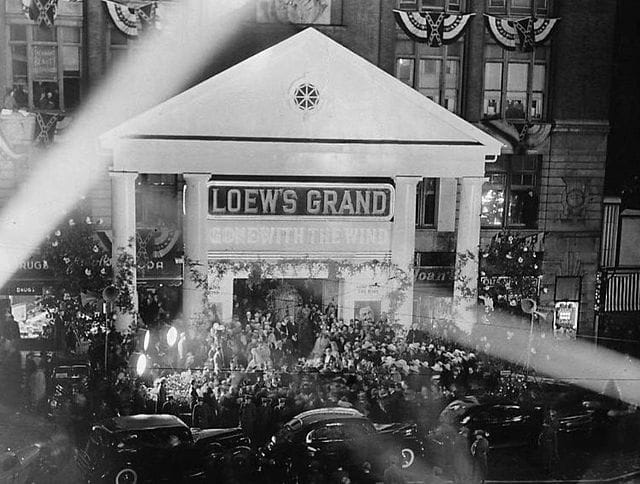
Setting and Historical Context
The novella is set in 1938–1939, during the so-called "Golden Age" of Hollywood. This period was marked by the dominance of the studio system, the rise of iconic stars, and the production of classic films such as Gone with the Wind.
The narrative follows Eve as she leaves New York City in September 1938, intending to return home to Indiana. However, on a whim, she decides not to disembark in Chicago, instead extending her journey to Los Angeles.
Hollywood at this time was a hub of glamour and intrigue, with lavish parties, powerful studio executives, and a culture of both opportunity and risk, especially for newcomers and women seeking independence.
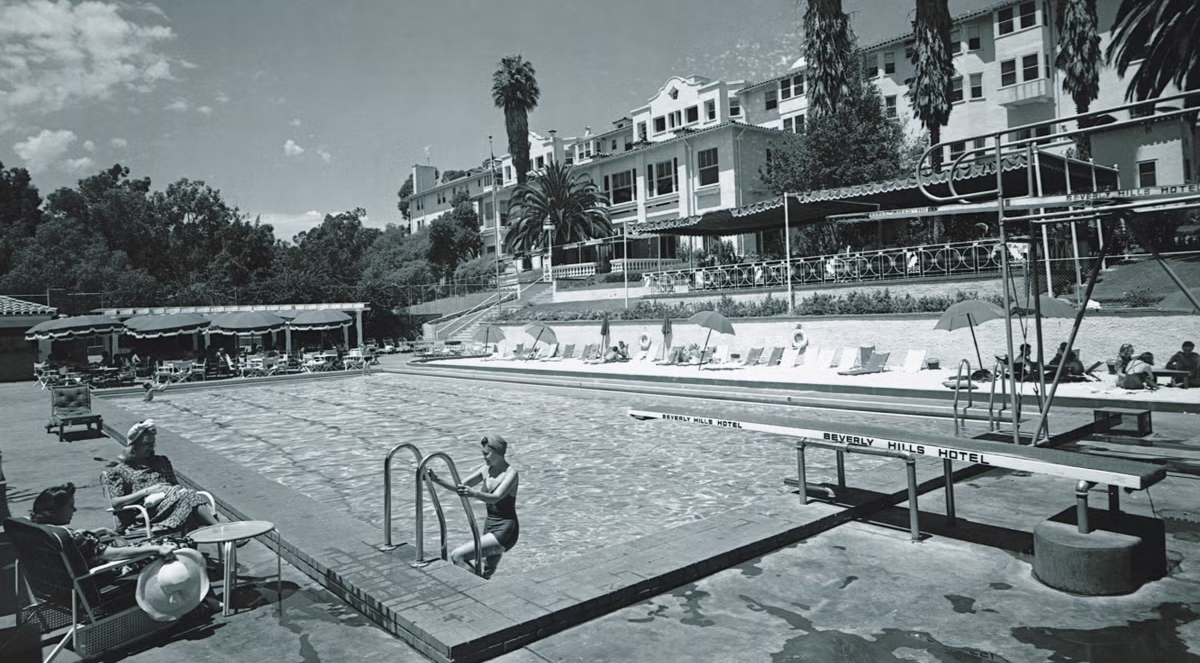
Encounters with Historical Figures and Events
In the novella, Eve befriends real-life actress Olivia de Havilland, who was then rising to fame and had just been cast as Melanie in Gone with the Wind (released in 1939).
Eve is depicted attending Hollywood parties, frequenting famous venues such as the Tropicana Club and the Beverly Hills Hotel, and ultimately finding herself on the set of Gone with the Wind.
The story is interwoven with references to the social and professional dynamics of the era, including the influence of gossip magazines, the prevalence of blackmail and scandal, and the precariousness of stardom.
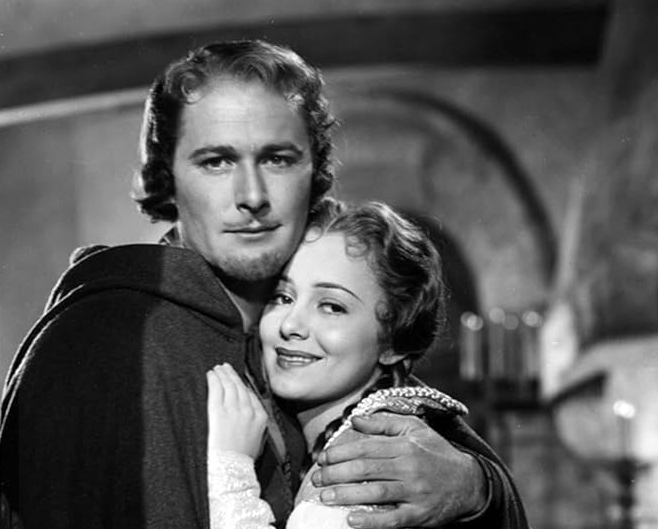
Fictionalization and Historical Accuracy
While Eve Ross is a fictional character, the novella is rich in period detail and features interactions with actual historical figures, most notably Olivia de Havilland.
The settings—such as the Golden State Limited train, the Beverly Hills Hotel, and the Santa Monica piers—are all real locations that evoke the atmosphere of late-1930s Los Angeles.
The plot’s central incident, in which Eve helps Olivia de Havilland out of a potential career-ending scandal, is a fictional invention but draws on the real pressures and vulnerabilities faced by actresses in the studio era.
Literary and Historical Significance
The novella provides a window into the gender and power dynamics of Hollywood’s Golden Age, highlighting both the opportunities and dangers for women who sought autonomy in a male-dominated industry. Towles’s depiction of Eve’s reinvention in Hollywood is both a tribute to the resilience of women of the era and a celebration of the city’s mythic allure.


Eve in Hollywood, the novella in Amor Towles' Table for Two, is set in the Golden Age of Hollywood—think movie sets, bungalows, and dive bars of late 1930s Los Angeles. To immerse your book club in Eve’s world, draw inspiration from the era’s glitz, intrigue, and sophisticated style.
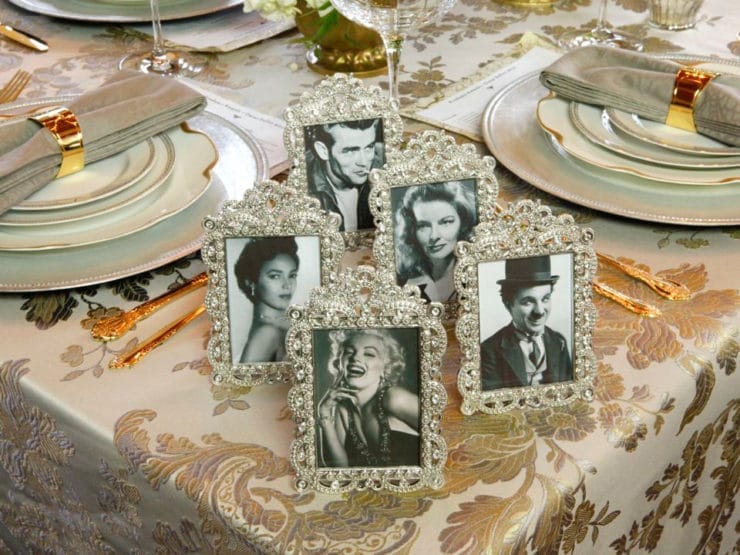
Hollywood Glamour Theme
- Color Palette: Use black, gold, ivory, and touches of deep red or emerald to evoke old Hollywood luxury.
- Table Linens: Elegant tablecloths or runners in satin or velvet. Consider art deco patterns or geometric designs reminiscent of the 1930s.
- Centerpieces: Arrange framed vintage photos of Hollywood stars on the serving table. PRINTABLE PHOTOS INCLUDED WITH PRINTABLE BOOK CLUB KIT. Add faux pearls, feathers, or film reels for a cinematic touch.
- Florals: Classic arrangements with white lilies, red roses, or dahlias in vintage vases or champagne coupes, reflecting the era’s opulence.
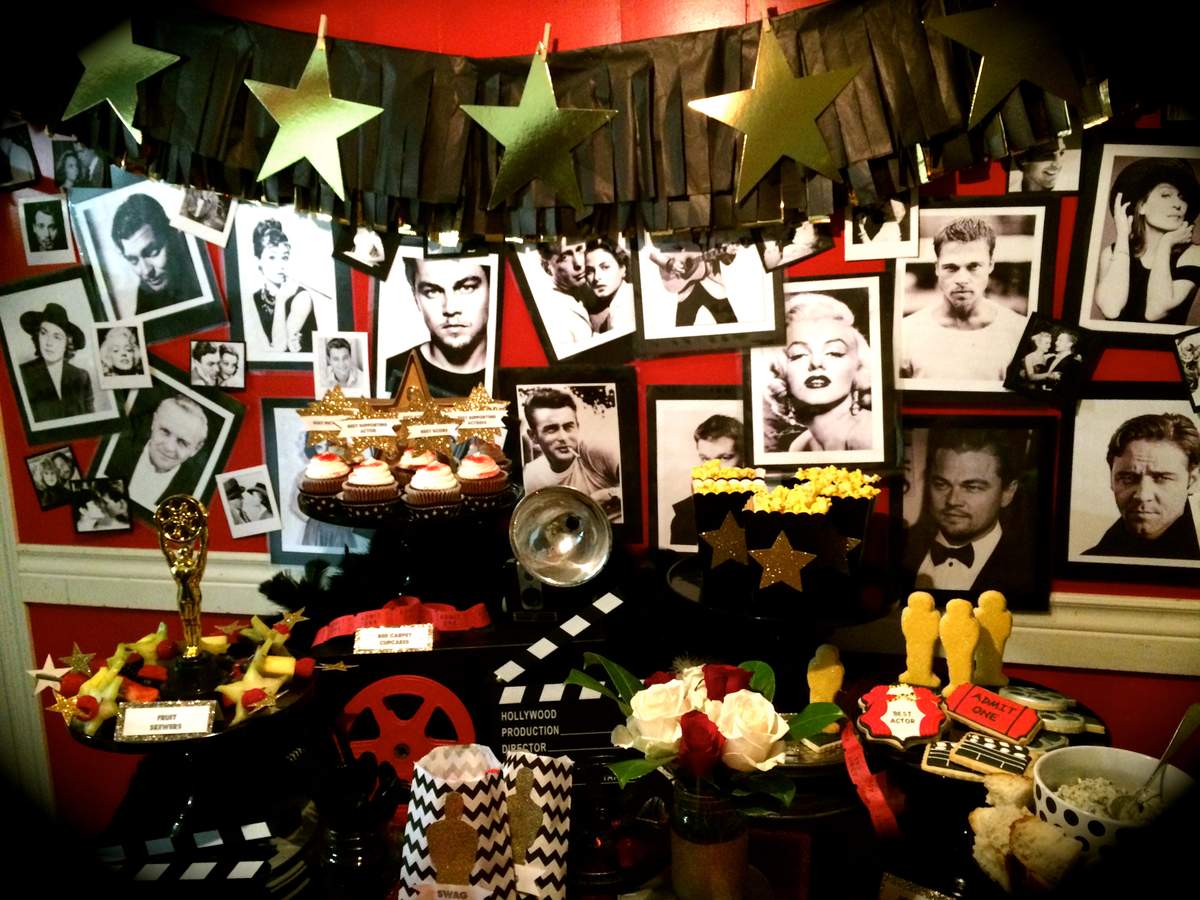
Movie Set Details
- Hollywood Photo Cards: Arrange on the table photos of famous 1930s Hollywood landmarks or studios (e.g., "The Brown Derby," "Paramount Lot," "Beverly Hills Hotel"). PRINTABLE PHOTOS OF VINTAGE HOLLYWOOD LOCATIONS ARE INCLUDED WITH THE PRINTABLE BOOK CLUB KIT.
- Props: Scatter old movie magazines, replica Oscar statuettes, or clapboards on the table.
- Backdrop: Hang a DIY “Hollywood” sign or a black-and-white photo collage of classic movie stars to set the mood.
Ambiance
- Music: Play a playlist of 1930s jazz, swing, or classic Hollywood film scores in the background.
- Lighting: Dim the lights and use candles or art deco lamps to create a moody, noirish atmosphere, nodding to the novella’s noir tone.
- Dress Code: Encourage members to dress in 1930s-inspired attire—think pearls, gloves, fedoras, or vintage dresses—for added fun and immersion.
These decorating ideas will transport your book club into the world of Eve in Hollywood, making your discussion as elegant and memorable as a night out in Tinseltown’s.

"Cast the Movie" Icebreaker Activity: Instructions for this activity are found in the Printable Kit.
"Literary Grab Bag" Icebreaker Activity: Instructions for this icebreaker are found in the Printable Kit.
"Alphabet Soup" Icebreaker Activity: Instructions for this icebreaker are found in the Printable Kit.

Main Dishes
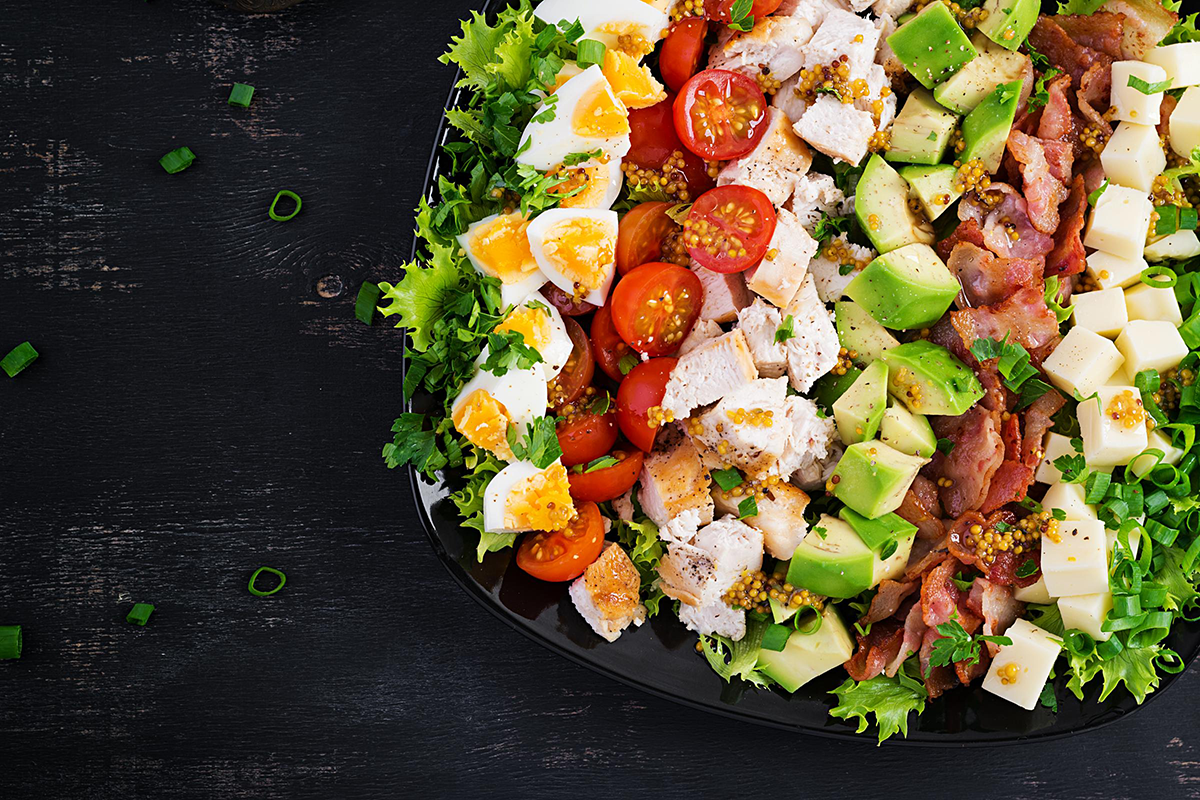
- Cobb Salad
This classic was popularized in Hollywood during its golden years and connects to the Los Angeles setting in some of Towles’ stories. It’s a vibrant, composed salad with chicken, bacon, avocado, blue cheese, eggs, and tomatoes—perfect for a light yet satisfying main.
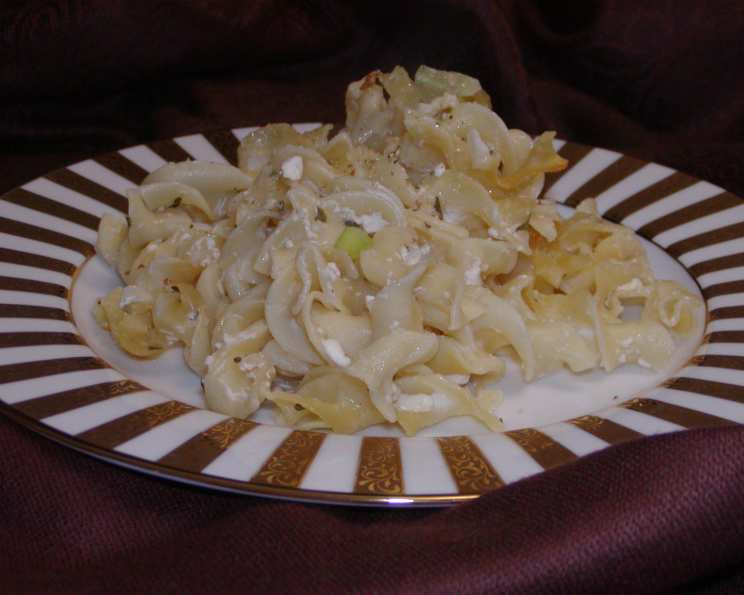
- Noodles Romanoff
Created by Michael Romanoff at his famed Hollywood restaurant, this creamy, cheesy noodle dish brings a touch of retro glamour to your table, nodding to the book’s old Hollywood atmosphere. - Roast Chicken with Lemon, Rosemary, and Garlic
Inspired by a passage in the book that contrasts the simplicity and perfection of a small roast chicken with the excesses of a traditional Thanksgiving turkey, this dish is both elegant and easy to share at a table for two. - New York-Style Pizza
If you don't want to take the time to cook, order in pizza. Who doesn't love pizza?

Snacks
- Bagged Popcorn
Have a bag of popcorn for each member to snack on during discussion time.

Dessert
- New York Cheesecake with Strawberries Romanoff
This dessert pairs the classic New York treat with a strawberry sauce inspired by Romanoff’s, bridging the book’s New York and Hollywood settings in a sweet finale.
Beverage Pairings
- Classic Cocktails
Consider serving a Manhattan or a Moscow Mule to represent the cities featured in the stories. - Sparkling Water or Wine
Offer sparkling water with lemon or a crisp white wine for a sophisticated, understated touch.
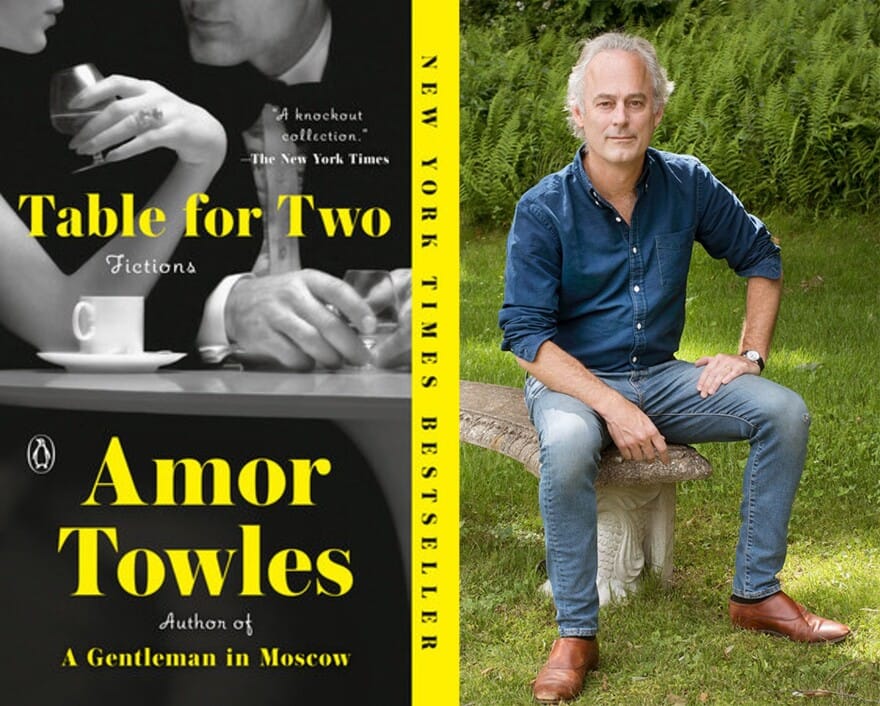
Get Amor Towles Books
Towles is sheer pleasure to read!
Bookshop.org was created as a socially conscious alternative to Amazon, with the goal of helping local, independent bookstores thrive. This is why Readers With Wrinkles supports their efforts. Please join us in this effort by purchasing your next read here.
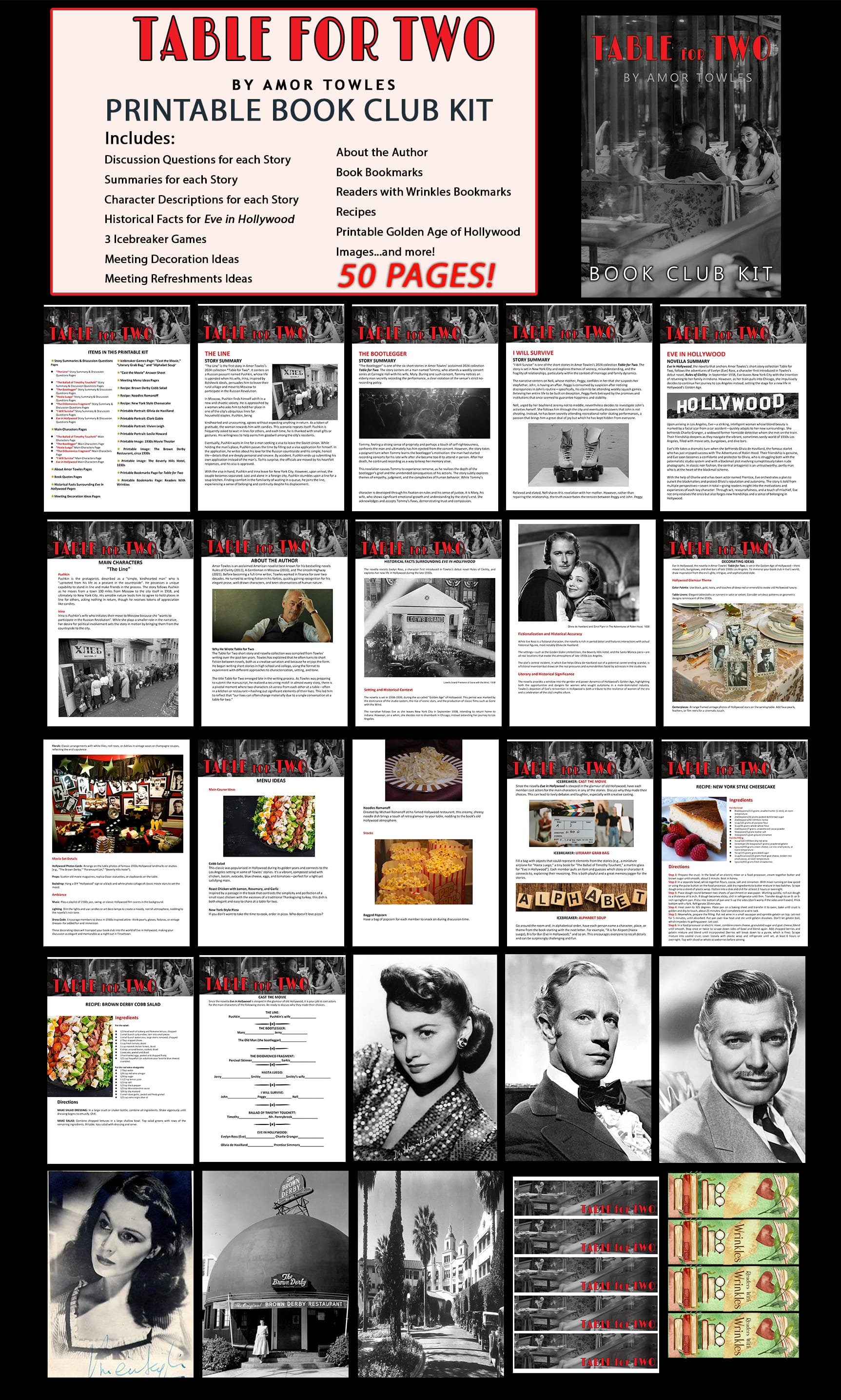
Table for Two printable BOOK CLUB KIT
The RWW book club kits provide everything you need to organize a great meeting with insightful discussions. These resources simplify book club preparation with character lists, book quotes, refreshment suggestions, recipes, and carefully prepared book club questions!

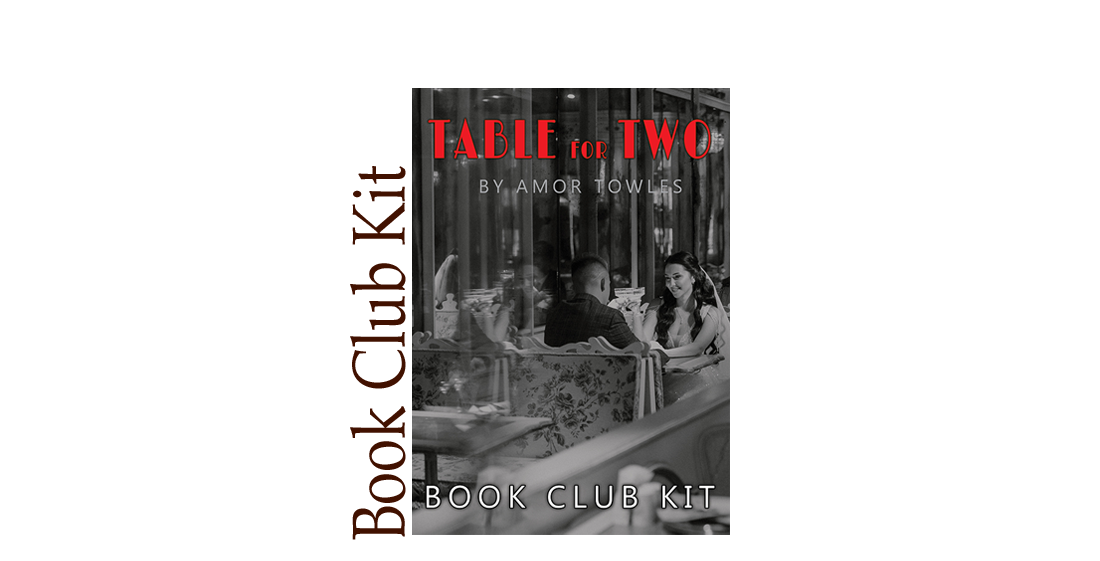
Comments